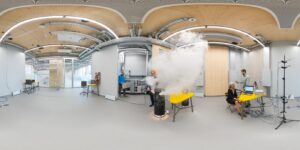Liginullenergiahoonete uurimisrühm
Zero Emission Buildings research group


Prof. Martin Thalfeldt
Tallinn University of Technology,
School of Engineering,
Department of Civil Engineering and Architecture
Introduction
This research group was established 2012 as nearly zero energy research group, now focusing to zero emission buildings energy and indoor climate aspects. Professors Jarek Kurnitski and Martin Thalfeldt, are responsible for teaching of energy performance in buildings, HVAC systems, indoor climate and smart buildings. With 10 active PhD students and some senior researchers and postdocs, the number of personnel is about 20 persons. With other groups, there is intensive cooperation with prof. Ergo Pikas to incorporate construction management and economics competence, with prof. Targo Kalamees regarding renovation technology and prof. Eduard Petlenkov regarding AI and data science.
Competence
ZEB research group represents key competencies and teaching responsibilities in the
following domains:
- Heating, ventilation and air conditioning (HVAC)
- Indoor climate
- Energy performance of buildings
- Energy systems, districts and building stock modelling
- Energy flexibility and demand side management
- Data driven energy and indoor climate analyses
Research topics
The main research topics have been focused on technical solutions and system integration for NZEB most urgently needed in Estonia, but also to NZEB/ZEB development in Europe and worldwide. In addition to solutions for new buildings, the group has been extensively working on renovation and development of energy calculation methodology.
The research infra includes the NZEB technological research facility as a full-scale test building, climate chambers for controlled laboratory experiments, ventilation air distribution laboratory, and heating and ventilation teaching laboratories.
The group has contributed to European NZEB technical definitions and system boundaries preparation especially through REHVA NZEB Task Force, EPBD 2nd generation standards development in CEN TC371, TC156 and TC228 standardization committees, European COVID-19 ventilation guidance development in REHVA COVID-19 Task Force and Post-COVID infection risk-based ventilation design method development in Nordic Ventilation Group. Moreover, Kurnitski contributed in the WHO Environment and Engineering Control Expert Advisory Panel (ECAP) for COVID-19 to the development of WHO Ventilation Roadmap, and as a member of Group 36 Plus, he was one of scientist providing evidence on SARS-CoV-2 airborne transmission and emphasising the need to develop ventilation standards to explicitly consider infection control. In Estonia, the group has had a leading role in energy action plan ENMAK 2030+ buildings part, Long Term Renovation Strategy 2020-2050, final energy savings targets 2024-2030 NCEP preparation as well as Estonian NZEB requirements and energy calculation methodology development (currently in force).
Some examples of research topics and outcomes:
- Contribution to WHO guidelines for Indoor Air Quality, Dampness and Mould, ventilation
chapter; - Heat emission efficiency measurement and simulation methodology development for EN15306-2;
- Occupancy and internal heat gain schedules development for prEN16798-1 and ISO 17772- 1;
- Geothermal energy piles and ground source heat pump modelling in a whole building simulation environment for heating and free cooling purposes;
- Overheating prevention solutions and temperature simulation based compliance assessment methodology development for residential buildings;
- Development and validation of simplified energy performance compliance assessment tool for Estonian regulation based on the specific heat loss correlation;
- Quantification of economic benefits and job creation through renovation of apartment buildings;
- Scenario analyses for energy savings and investment needs within the framework of the Estonian energy action plan ENMAK 2030+;
- Preparation of European NZEB technical definitions and system boundaries – REHVA nZEB definition 2013, within REHVA NZEB task force and cooperation with CEN;
- Preparation of the Estonian regulation on minimum energy performance requirements, calculation methodology and the energy performance certificate, covered by the regulatory acts of MKM m63 2008, 2012, 2018 and 2024, MKM m58 2008, 2012, 2019 and 2024 and MKM m36 2012, 2019 and 2024;
- Development of completely new Estonian regulation for the indoor climate and ventilation requirements since 2015, expected to be published in 2025;
- Preparation of the Estonian Long Term Renovation Strategy 2020-2050
- Development of European REHVA COVID-19 ventilation guidance, Estonian COVID-19 ventilation regulation and guidance for ventilation systems operation and improvements 2020-2021;
- Development of new design method for post-COVID ventilation design, intended to
complement EN 16798-1:2019 standard, proposal published by European and Scandinavian professional organisations REHVA and SCANVAC 2022. - Preparation of final energy saving targets for Estonian 2024-2030 NCEP, 2022-2023;
- Development of photovoltaic web calculator for Estonian energy performance regulation, including storage and self-use hourly calculation, 2023;
- Development of zero emission building energy calculation assessment boundary based on the total primary energy 2024, within REHVA EPBD Implementation Guidance Task Force;
- Ongoing revision of EN 16798-1:2019 standard in CEN TC156 WG25, especially to include design for airborne transmission/infection risk, demand controlled operation and health aspects, 2023-2026.
Research infrastructure | Short description |
NZEB technological test | Rooms of 100 m2 test building can simulate office, school or a dwelling. It is equipped with HVAC and automation systems and has been used to study heating, ventilation and cooling systems and components performance in real operation. Facades can be replaced that is used for building physics studies. |
Ventilation air distribution laboratory | Air distribution laboratory of 45 m2 and 3.7 m height has its own air handling unit. It allows to measure airflow patterns from supply and room conditioning units, air jets, throw lengths and tracer gas spread. It has been used for ventilation effectiveness and airborne virus transmission research. |
IoT platform and cloud data store for energy and IEQ monitoring and analytics | IoT platform and APIs for real time energy and indoor climate performance monitoring. Currently 45 buildings are connected with either existing BACS sensors & energy meters or new installed ones. Automated energy performance certificate generation and dedicated performance analytics are tested. |
Multipurpose climatic chambers | Interior and exterior climate chambers enable to study building envelope components and HVAC equipment at controlled climatic conditions. Some examples are frost resistance measurements of interior insulation systems and frost formation measurements of heat exchangers of ventilation units. |
VAV & DCV stand | Well-equipped variable air flow and demand controlled air flow stand for airflow control testing and simulation models calibration. Intended for studying both dedicated and robust equipment for indoor air quality regulation and monitoring. |















